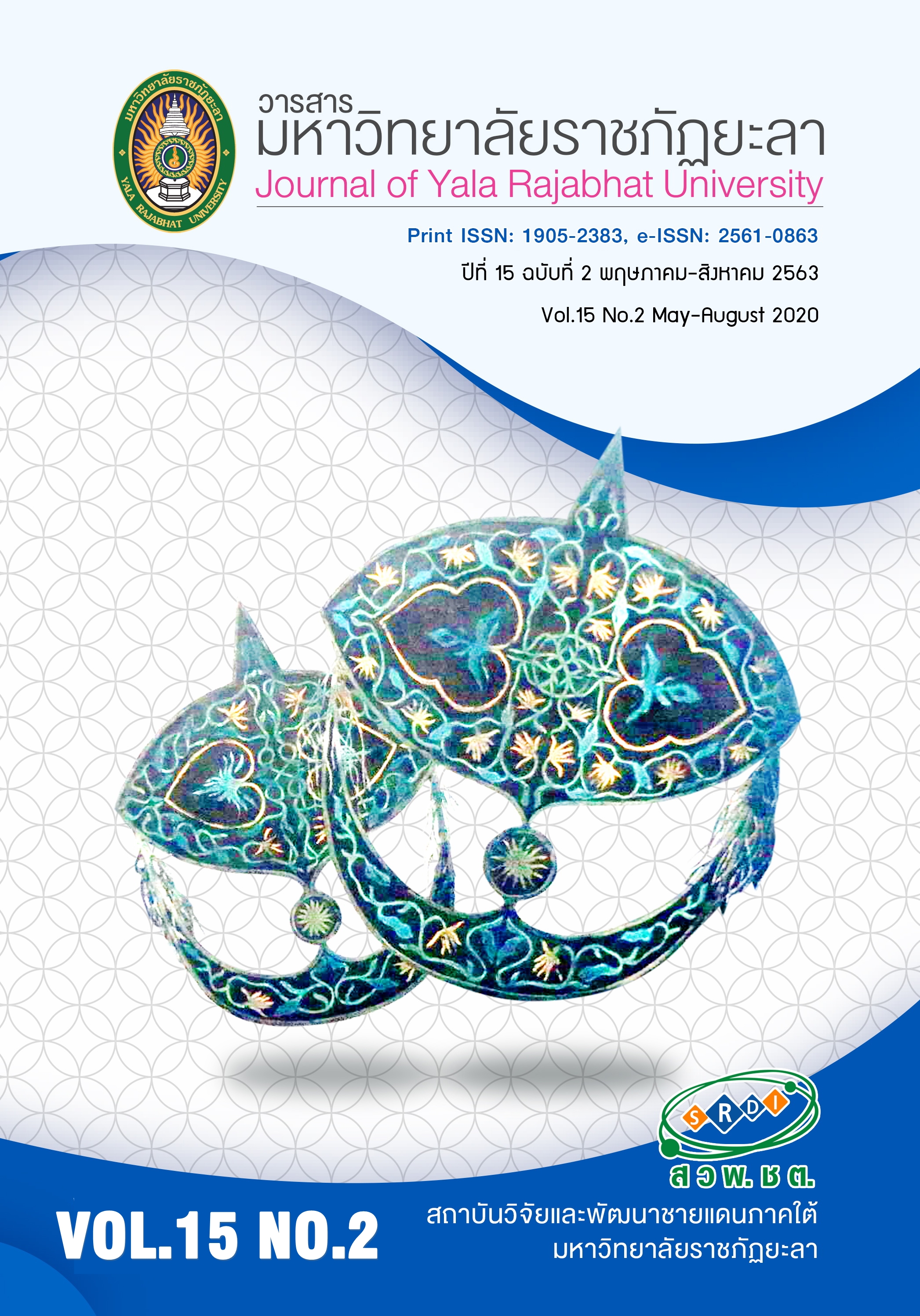ประสิทธิภาพของการให้ผลสะท้อนกลับโดยครูและโดยเพื่อนต่อความสามารถในการเขียน ของนักเรียนที่เรียนภาษาอังกฤษเป็นภาษาต่างประเทศ
Main Article Content
บทคัดย่อ
การศึกษาเปรียบเทียบนี้เพื่อศึกษาประสิทธิภาพของการให้ผลสะท้อนกลับโดยครูกับการให้ผลสะท้อนกลับโดยเพื่อนต่อความสามารถในการเขียนของนักเรียนที่เรียนภาษาอังกฤษเป็นภาษาต่างประเทศผ่านการเขียนบันทึกโต้ตอบ กลุ่มตัวอย่างเป็นนักเรียนชั้นมัธยมศึกษาปีที่ 4 จำนวน 50 ในโรงเรียนมัธยมศึกษาเอกชนสอนศาสนาแห่งหนึ่งในจังหวัดยะลา กลุ่มตัวอย่างประกอบด้วยกลุ่มทดลอง 2 กลุ่มๆ ละ 25 คน คือ กลุ่มที่ได้รับผลสะท้อนกลับโดยครูและกลุ่มที่ได้รับผลสะท้อนกลับโดยเพื่อน เครื่องมือในการวิจัยคือ 1) แบบทดสอบการเขียนทั้งก่อนและหลังการทดลอง 2) การเขียนบันทึกแบบสนทนา (Dialogue journal) กลุ่มตัวอย่างทั้งสองกลุ่มต้องเขียนบันทึกแบบสนทนาสัปดาห์ละครั้งเป็นเวลา 10 สัปดาห์ และมีการแลกเปลี่ยนบันทึกแบบสนทนาและได้รับผลสะท้อนกลับโดยครูและเพื่อน ผลการวิจัยพบว่า การให้ผลสะท้อนกลับโดยเพื่อนช่วยพัฒนาความสามารถทางการเขียนด้านความสามารถในการเขียนโดยรวมและความคล่องในการเขียนดีกว่าการให้ผลสะท้อนกลับโดยครูอย่างมีนัยสำคัญที่ระดับ .01 อย่างไรก็ตามทั้งการให้ผลสะท้อนกลับโดยครูและโดยเพื่อนไม่ได้ช่วยพัฒนาความสามารถในการเขียนด้านความถูกต้องทางไวยากรณ์แต่อย่างใด
Article Details
บทความ ข้อมูล เนื้อหา รูปภาพ ฯลฯ ที่ได้รับการเผยแพร่ในวารสารมหาวิทยาลัยราชภัฏยะลานี้ ถือเป็นลิขสิทธิ์ของวารสารมหาวิทยาลัยราชภัฏยะลา หากบุคคลหรือหน่วยงานใดต้องการนำทั้งหมดหรือส่วนหนึ่งส่วนใดไปเผยแพร่ต่อหรือกระทำการใดๆ จะต้องได้รับอนุญาตเป็นลายลักษณ์อักษรจากวารสารมหาวิทยาลัยราชภัฏยะลาก่อนเท่านั้น
References
2. Denne-Bolton, S. (2013). The dialogue journal: A tool for building better writers. English Teaching Forum, 51(2), 2-11.
3. Ellis, R. (1985). Understanding second language acquisition. Oxford: Oxford University Press.
4. Ferris, D. R. & Hedgcock, J. (2005). Teaching ESL composition: Purpose, process, and practice. Routledge. New Jersey: Lawrence Erlbaum Associates, Inc.
5. Foroutan, M., Noordin, N. & Gani, M.S. (2013). Use of e-mail dialogue journal in enhancing writing performance. Asian Social Science, 9(7), 208-217.
6. Krashen, S. (1992). Fundamentals of language education. Torrance, CA: Laredo Publishing Company.
7. Kulprasit, W. & Chiramanee, T. (2012). Impact of journal writing with peer feedback on EFL students’ writing ability [Online]. Retrieved September 15, 2017, from: http://kb.psu.ac.th/psukb/bitstream/2016/10394/1/358426.pdf.
8. Liao, M. T. & Wong, C. T. (2010). Effects of dialogue journals on L2 students’ writing fluency, reflections, anxiety, and motivation. Reflections on English Language Teaching, 9(2), 139-170.
9. Linnell, K. M. (2010). Using dialogue journals to focus on form. Journal of Adult Education, 39(1), 23–28.
10. O'Malley, J. M. & Chamot, A. U. (1990). Learning strategies in second language acquisition. Cambridge: Cambridge University Press.
11. Obrom, S. (2013). Improving ability in writing English sentences using the dialogue journal approach [Online]. Retrieved September 15, 2017, from: https://www.spu.ac.th/tlc/files/2013/10.
12. Peyton, J. K. (1993). Dialogue journals: Interactive writing to develop language and literacy. ERIC Digest. Washington DC: ERIC Clearinghouse on Languages and Linguistics.
13. Puengpipattrakul, W. (2009). The use of dialogue journals to develop grammatical accuracy in writing [Online]. Retrieved July 8, 2017, from: http://www.manusya.journals.chula.ac.th/files/essay/Walaipun_p.90-108_new.pdf.
14. Rattanaintanin, S. (2017). Using dialogue journals to enhance students' writing ability and willingness to orally communicate [Online]. Retrieved September 15, 2017, from: http://kb.psu.ac.th/psukb/handle/2016/11729.
15. Rokni, S.J.A. & Seifi, A. (2013). The effect of dialogue journal writing on EFL learners' grammar knowledge. Journal of Language and Linguistic Studies, 9(2), 57-67.
16. Rollinson, P. (2005). Using peer feedback in the ESL writing class. ELT journal, 59(1), 23-30.
17. Routman, R. (1991). Invitation: Changing as teachers and learners K-12. Portsmouth, NH: Heinemann.
18. Saengklaijaroen, W. (2012). The ability of writing guided and free compositions through the use of explicit and implicit-cues-responding techniques. Journal of Yala Rajabhat University, 7(1), 61-72.
19. Tuan, L. T. (2010). Enhancing EFL learners’ writing skill via journal writing. English Language Teaching, 3(3), 81-88.
20. Yoshihara, R. (2008). The bridge between students and teachers: The effect of dialogue journal writing [Online]. Retrieved September 3, 2017, from: http://jalt-publications.org/files/pdf-article/32.11art1.pdf.

